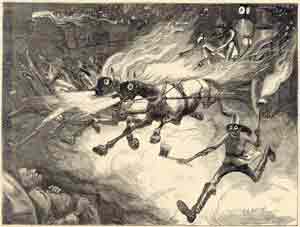
Birth of A Fire Department

"Fire! Fire! A New Yorker's Nightmare."
From Harper's Weekly, February 8, 1873.
The Common Council, realizing in 1731 that the economic loss from fires was becoming larger, purchased two state-of-the-art fire engines from London. The engines needed about 20 men to pump the water to the fire and several more to transfer water by bucket to the engine. The following year, the first firehouses were born when the council appointed an alderman to oversee the two engines and built two sheds to house them. By December 1737, the General Assembly of the colony authorized the establishment of a volunteer fire department. Despite their volunteer status, there was a sense of professionalism that surrounded the new companies; firemen received exemptions from militia service and jury duty, a practice that remained for another century and a half
On March 18, 1741 fire broke out at the governor’s house located
in today's Battery Park. It quickly spread to and destroyed the adjacent
buildings in Fort George that housed the British troops. This was a great
defeat for the volunteer force. Soon after, several other fires errupted
outside the fort walls. Rumors of sabotage by enslaved Africans abounded
and several people were burned to death after confessing to the fire conspiracy.
The city, however, never really proved the existence of a plot. The rash
of fires caused the council to recruit more firemen, appoint more watchmen
and organize two additional engine companies. Within 25 years, the volunteer
fire department had grown to include 170 men and eight engine companies.
Volunteers were overwhelmingly artisans and tradesmen. In addition to
the engine companies, two hook-and-ladder companies were formed. Engine
companies pumped water on the fire and ladder companies tore down walls
and ceilings to ventilate the fire. This division of labor, which requires
close coordination, remains in practice to this day. At this moment of
expansion, the department began to create a command structure. By the
1760s there were a chief engineer and two assistants to head the department.
Fire companies were assigned to specific city wards and firefighters were
attached to specific companies.
During the revolutionary war, in the summer of 1776, the city experienced
yet another major fire. George Washington had decided that the city would
be difficult to defend against the British and withdrew his forces on
September 12, 1776. Three days later the British occupied the city and
on September 21st, a fire broke out in the Fighting Cocks Tavern. Without
the city’s firemen present, the fire quickly spread. A third of
the city was burnt, destroying 493 houses. The British solders attempted
to extinguish the flames with sabotaged equipment, but since they were
uable to fight the fire effectively, it raged on from day into night.
Because the British were convinced that the fire was deliberately set,
they arrested 200 suspected sympathizers and hung the self-described American
spy Nathan Hale. The British made little attempt to rebuild the city but
did try to reconstitute the fire department.